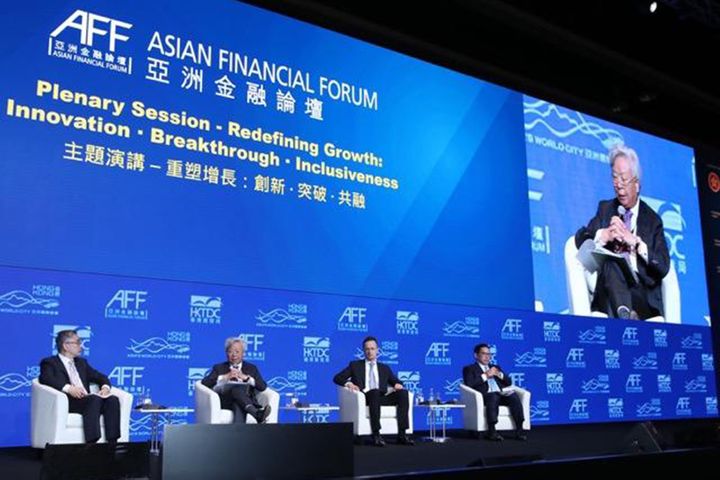 Asian Financial Forum Sees Innovation, Regional Cooperation as Key Growth Drivers
Asian Financial Forum Sees Innovation, Regional Cooperation as Key Growth Drivers(Yicai Global) Jan. 14 -- Innovative measures used in sustainable development and enhanced collaboration between regions were among the topics discussed at this year's Asian Financial Forum, where some of the world's top financial brains came together to find new ways for the global economy to resume growth.
Despite the doom and gloom surrounding the world's economy, several major policies, such as China's development of the Greater Bay Area as well as the Belt and Road Initiative, are all opportunities for global and regional growth, said Margaret Fong, executive director of the Hong Kong Trade Development Council.
The Chinese economy has been transitioning to high-quality development from rapid growth and will continue to drive long-term economic growth in Asia, Fong said at this year's two-day AFF in Hong Kong, which wraps up today.
Global uncertainties will remain this year as geopolitics heat up and the financial markets remain highly volatile, she added. The world has entered an era of low interest rates, where low inflation is here to stay and the choice of monetary policy is unclear.
Centering on the theme of Redefining Growth: Innovation, Breakthrough, Inclusiveness, over 100 financial regulators, businessmen, economists and investors from around the world gathered at the AFF to discuss key global economic and financial issues.
Sustainable Development
Last October, the International Monetary Fund trimmed its expectation for global economic growth this year to 3.4 percent, the slowest rate since the global financial crisis. How can the world economy resume economic growth?
The Beijing-based Asian Infrastructure Investment Bank's model of driving sustainable infrastructure spending and construction serves as a good example. Since it started business four years ago, the AIIB already boasts 102 member countries and regions. It has USD40 billion in infrastructure investments and extended USD12 billion in loans.
The AIIB will invest between USD10 billion and USD15 billion each year in infrastructure, said President and Chairman of the Board of Directors Jin Liqun.
The bank has a duty to help members transfer to a low- and zero-carbon economic development model from a high-carbon one to ensure the development of a green economy. To realize this goal, the AIIB supports certain innovative measures, especially those linked to infrastructure investment and fundraising. For example, it introduced an environmental, social and governance-based credit mechanism to drive ESG-based infrastructure investments.
The AIIB also wants to create conditions for Asia's sustainable development with innovative financing methods.
"We want to ensure that our support for infrastructure development does not significantly impact the ecosystem," Jin added. "We want to make sure that our financing is sustainable and countries that borrow from us won't encounter any debt traps or problems. Our infrastructure helps these countries improve their financial incomes and reduce debt, not increase it."
Hong Kong, Greater Bay Area
"Despite internal or external challenges, Hong Kong's financial market has remained stable and the banking system is still running smoothly with ample liquidity," Financial Secretary of Hong Kong Paul Chan said at the forum.
Hong Kong's initial public offering market was worth USD40 billion last year, remaining the world's largest for the seventh year running. Listed firms had a total market capitalization of USD4.9 trillion, 14 times Hong Kong's gross domestic product, Chan said.
Many participants expressed confidence in Hong Kong's prospects, saying that although the special administrative region faces challenges and difficulties, they also saw a lot of opportunity.
The Greater Bay Area has a population of 71 million population and a GDP of USD1.7 trillion. Funds allocated to the area are expected to reach CNY1.6 trillion (USD232.3 billion). Enhanced collaboration between its three regions – Guangdong province, Hong Kong and Macao -- will be a strong engine for growth.
Stock, Bond Connect Programs
Mutual market access schemes such as the Shanghai-Hong Kong Stock Connect, the Shenzhen-Hong Kong Stock Connect and the Bond Connect also reflect how well the Hong Kong and mainland markets complement each other.
The Shanghai-Hong Kong Stock Connect allows investors in Hong Kong and on the mainland to trade stocks regardless of where the firms went public, Ba Shusong, managing director and chief China economist of Hong Kong Exchanges and Clearing, told Yicai Global.
The Bond Connect has become the main channel for foreign investors to enter the mainland debt market. Overseas institutional investors' holdings of yuan-denominated bonds rose to CNY2.12 trillion as of the end of September.
The Exchange Traded Fund Connect, bridging Hong Kong and the Chinese mainland's ETF markets, is expected to accelerate this year depending on the business environment.
In addition, there is strong demand for financial institutions in Guangdong, Hong Kong and Macao to better develop and coordinate cross-border financing. Interlinking infrastructure construction, the development of new economic enterprises, demand for cross-border payment services, for mutually recognized vehicle insurance and for the high-quality life and property insurance products sold in Hong Kong are all opportunities for development.
Editor: Kim Taylor